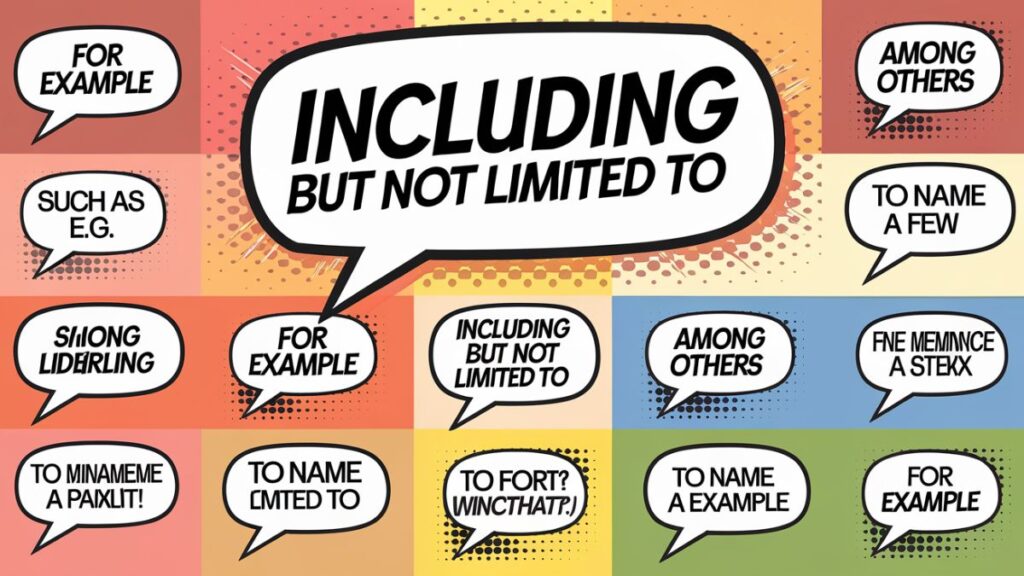In professional, academic, and legal writing, the phrase 12 Other Ways to Say “Including But Not Limited To” is commonly used to introduce examples while implying that the list remains open-ended. However, relying on the same phrase repeatedly can make writing redundant, formal, or even monotonous.
This article explores “12 Other Ways to Say ‘Including But Not Limited To'” and provides context on when to use them. Additionally, it highlights synonym selection, word choice mastery, and language usage to ensure communication clarity in different settings.
A Non-Exhaustive List Includes
A phrase often used in professional communication, “A Non-Exhaustive List Includes” ensures clarity while maintaining flexibility. This alternative is particularly useful in business writing, legal documents, and technical reports where comprehensiveness is necessary. It signals that additional elements could be included, avoiding unnecessary restrictions.
Using “A Non-Exhaustive List Includes” enhances communication clarity while offering necessary flexibility in defining lists. It aligns well with business communication strategies that require precise language usage and structured information dissemination.
Some Options Are

For more relaxed and casual communication, “Some Options Are” is an excellent alternative. This phrase conveys the same open-ended intent as “Including But Not Limited To,” but in a friendlier tone, making it ideal for team discussions, brainstorming sessions, or customer interactions.
When listing choices informally, using “Some Options Are” keeps the message approachable. It encourages participation and leaves room for additional ideas without sounding overly rigid. For instance, an email discussing potential team-building activities might include: “Some options are a weekend retreat, an online workshop, or a game night.”
This phrase works well in customer service and marketing communications. By presenting a few choices and subtly suggesting that others exist, it fosters a sense of flexibility. For example, an e-commerce website might state, “Some options are expedited shipping, standard delivery, and local pickup.”
Because of its inclusive language, “Some Options Are” can be useful in polite email closings or general recommendations. The phrase allows the writer to provide suggestions without limitations, maintaining an open and engaging conversation style.
Such As, But Not Limited To
“Such As, But Not Limited To” balances formal and informal tones, making it highly versatile. It is commonly used in business, academic, and legal settings to indicate a few examples while implying that more exist.
This phrase is especially useful in policies, agreements, and guidelines where specifying some items is necessary, but room for interpretation must remain. For instance, an employee handbook might state: “Appropriate office attire includes items such as, but not limited to, dress pants, blouses, and closed-toe shoes.”
In professional settings, this phrase helps ensure language precision without restricting scope. It signals that while the examples listed are relevant, additional considerations should also be made. This approach prevents misinterpretation while providing communication clarity.
Compared to simpler alternatives, “Such As, But Not Limited To” adds a layer of professionalism. It ensures the audience understands that the provided examples do not form an exhaustive list, which is particularly helpful in compliance documents, technical writing, and business presentations.
Including, But Not Limited To
This commonly used phrase ensures clarity while maintaining inclusivity in language. It is frequently seen in contracts, policies, and business documents, providing an easy way to present examples without restricting potential additions.
Using “Including, But Not Limited To” allows for semantic variation while keeping the tone professional yet accessible. It helps avoid legal misinterpretations and ensures flexibility when listing important items. For example, a company policy may state: “Our benefits package includes, but is not limited to, health insurance, retirement plans, and paid time off.”
Incorporating this phrase into workplace interactions helps maintain a formal but adaptable approach. It allows businesses to specify key points while ensuring that additional relevant factors are still considered. This is particularly useful when defining job roles, project scopes, or service offerings.
Overall, “Including, But Not Limited To” is a reliable, widely accepted phrase that ensures precise yet adaptable communication in both legal and everyday business contexts.
Like, But Not Limited To
A casual alternative to “Including, But Not Limited To,” this phrase is best suited for conversational and informal writing. It keeps things approachable while still allowing room for additional examples.
“Like, But Not Limited To” is commonly used in team meetings, internal emails, and casual conversations. It works well when discussing ideas in an open-ended way. For instance, a project lead might say, “We need to focus on aspects like, but not limited to, customer engagement, product quality, and pricing strategies.”

This phrase helps maintain a friendly and engaging tone, which is crucial in team-building discussions and brainstorming sessions. It allows participants to contribute ideas without feeling confined by a set list of options.
Although this phrase is more relaxed, it still provides clarity in professional settings. It is perfect for situations where formal phrasing is unnecessary but inclusivity in language is still important.
Comprising, But Not Limited To
This phrase is a strong option for formal business writing and legal communication. It maintains professionalism while ensuring communication clarity and inclusivity.
“Comprising, But Not Limited To” is often used when discussing comprehensive lists. For example, in a company’s policy document, a sentence might read: “The job responsibilities comprise, but are not limited to, client management, report generation, and process optimization.”
Using this phrase helps maintain word choice mastery, ensuring that communication remains professional, precise, and legally sound. It is particularly useful when writing contracts, compliance policies, and financial reports.
This phrase supports effective meeting strategies and is often included in structured discussions where a detailed but non-restrictive approach is needed. Choosing the right phrase ensures professionalism and language adaptability in workplace communication.
Inclusive Of, But Not Limited To
Writers and speakers use “Inclusive of, but not limited to” to emphasize a broad range of possibilities. This phrase works well in legal documents, contracts, and policies where specificity matters, but flexibility remains necessary.
Business professionals often incorporate this phrase when outlining services, terms, or product features. For example, a company might state, “Our package is inclusive of, but not limited to, free delivery, product support, and extended warranty.” This ensures clarity while keeping options open.
Marketers and customer service teams use this expression to set expectations without appearing restrictive. Instead of listing every service in detail, they can highlight core offerings while leaving room for additional benefits.
Employing this phrase in workplace communication fosters transparency and flexibility. Teams can use it in project plans and role descriptions to define tasks while allowing room for evolving responsibilities.
With Examples Such As
Using “With examples such as” introduces clarity and specificity without suggesting a comprehensive list. This phrase works effectively in instructional materials, presentations, and reports where providing illustrations enhances understanding.
Teachers, trainers, and content creators rely on this phrase to simplify complex topics. They might say, “Digital marketing strategies, with examples such as SEO, email campaigns, and social media advertising, help businesses grow.” The structure ensures clarity while offering context.
Business leaders use this phrase in reports and proposals to support key points with relevant illustrations. Instead of making vague claims, they provide concrete examples to strengthen their message.
In daily communication, professionals can improve engagement by integrating real-world examples. Using relatable scenarios makes information more digestible and fosters better comprehension among audiences.
Comprised Of, But Not Limited To
“Comprised of, but not limited to” works well in legal and corporate language to define included elements while keeping the scope open. This phrase appears frequently in contracts, policy documents, and formal business statements.
A company might state, “The benefits package is comprised of, but not limited to, health insurance, paid leave, and retirement contributions.” This prevents misinterpretation and allows for additional perks without constant updates.

In technical writing, this phrase helps describe system components, processes, or data sets. Engineers and analysts use it to ensure flexibility while maintaining structure and clarity.
HR professionals and managers often include this expression in job descriptions to outline responsibilities while allowing for evolving roles. This ensures employees understand their primary duties without feeling restricted.
Containing, But Not Limited To
“Containing, but not limited to” emphasizes inclusivity while providing a clear starting point for a list. It commonly appears in product descriptions, safety guidelines, and ingredient lists.
Food manufacturers and pharmaceutical companies use this phrase to describe ingredients without making exhaustive claims. A label might read, “This supplement contains, but is not limited to, vitamins C, D, and B12.” This allows for potential formulation changes.
Instruction manuals and safety documents benefit from this phrase when detailing hazards or safety measures. It ensures readers understand key risks without assuming the list is exhaustive.
Writers and educators use this expression to create flexibility in definitions or classifications. By not limiting the scope, they ensure broader applicability and clearer communication.
As Exemplified By
“As exemplified by” introduces concrete examples to support a statement. This phrase works well in analytical writing, persuasive arguments, and educational materials where evidence strengthens credibility.
A marketing strategist might say, “Brand loyalty increases customer retention, as exemplified by companies like Apple and Nike, which have built strong followings through consistent branding and quality.” This enhances persuasiveness by providing real-world cases.
Educators and scholars use this phrase to clarify theories and concepts. Instead of vague descriptions, they offer well-known examples to reinforce their points.
Business analysts and consultants rely on this phrase in reports to showcase industry trends. By pointing to successful case studies, they make their findings more relatable and actionable.
Illustrated By, But Not Limited To
“Illustrated by, but not limited to” introduces examples in a structured way while maintaining openness. This phrase commonly appears in presentations, legal statements, and educational content.
Speakers and writers use this phrase to provide evidence without restricting interpretation. A research paper might state, “The effects of climate change are illustrated by, but not limited to, rising temperatures, increased natural disasters, and shifting weather patterns.”
Legal and policy documents use this phrase to provide guidelines while allowing room for adaptation. It ensures clarity without unnecessary rigidity.
Teachers and trainers incorporate this expression when breaking down difficult concepts. It allows them to guide learners through relevant examples while leaving room for additional insights.
Conclusion
Using “12 Other Ways to Say ‘Including But Not Limited To'” enhances word variation techniques, professional communication, and language adaptability. Whether writing a business email, a legal contract, or a creative blog post, selecting the right phrase improves communication clarity and engagement.
By mastering tone adjustment, semantic variation, and professional etiquette, you can ensure readability and inclusivity while maintaining precision. Next time you draft a report, contract, or email, try using these alternative expressions for a more polished and natural tone.

Jenni Maic is a creative wordsmith at Grammar Globe, where she brings humor and wit to the world of puns and English grammar. With a passion for playful language and a knack for simplifying grammar, Jenni’s articles make learning engaging and entertaining. Discover her work at https://grammarglobe.com/.






